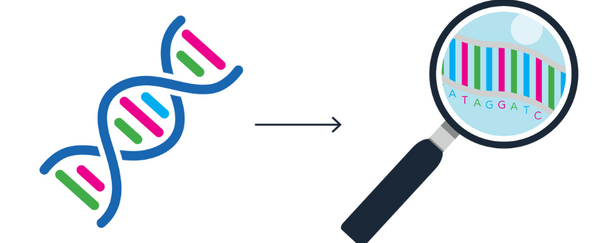Genomics 101: RNA vs DNA, what's the difference?
By Florence Cornish onIn this series, ‘Genomics 101’, we go back to basics and explore some of the most important topics in genomics. In this blog, we explain what is meant by RNA, how it is different from DNA, and why our body needs it.

First things first, what is DNA?
DNA is a molecule found in all living things. It carries the genetic information we need to survive, like an instruction manual for our body.
DNA sequences are made of a 4 different ‘bases’, which we represent using the letters A, T, C and G.
The cells in our body can read this sequence of letters, almost like reading a book, and produce all the different proteins we need to survive.
The order of the letters in the sequence determines which protein is produced.
So then, what is RNA?
Like DNA, RNA is also a molecule found in all living things. Its primary role is to copy the information stored in our DNA so it can be used to make proteins in our body.
There are several different types of RNA involved in producing proteins, each have a slightly different role to play.
Collectively, they can be thought of as messenger molecules, acting as the intermediary step between genetic information and proteins.

How does RNA copy DNA?
Good question! To answer this, we first need to talk about the structure of RNA molecules.
Like DNA, RNA molecules are also made up of bases. These are just like the ones in DNA, except for the base ‘T’, which is replaced by a different base, which we call ‘U’.
This means the complete set of RNA bases are A, U, G and C.
Using these bases, RNA forms a copy of the DNA sequence in a process we call ‘transcription’. RNA then relays this information to the parts of the cell that make proteins.
How are DNA and RNA different?
Aside from their function, the main difference between DNA and RNA is their structure. DNA molecules are what we call ‘double stranded’, meaning they are made up of 2 separate chains joined together in the middle.
Think of it as being shaped like a ladder; the molecule has 2 side rails joined together by several rungs, and it twists round to form the iconic double helix shape that you might have seen before.
RNA, on the other hand, is usually single stranded, as if the ladder has been cut in half straight down the middle.

Why do DNA and RNA have these differences?
DNA and RNA have different structures to suit their different functions.
DNA molecules are double stranded to make them more stable. They are also tightly coiled up and kept securely in a special part of the cell called the nucleus. This allows our genetic information to be stored safely throughout our lifetimes.
RNA molecules are single stranded, so much less stable. This means they can be broken down after use to avoid excess protein being produced.
RNA is also much smaller than DNA because it only copies a fraction of the full sequence. This means that RNA molecules are small enough to move out of the nucleus to the cell’s protein machinery.
Is DNA used in clinical settings?
It is! DNA contains the instructions for all the proteins in our body. Glitches in this instruction manual, or ‘genetic changes’, can lead to proteins that don't quite function correctly, in turn causing problems for our health.
We can examine a person’s DNA sequence to look for these glitches and find out the cause of the problem. In some cases, we can even target treatment towards a specific genetic change.
To find out more about this, check out our previous Genomics 101 blog: What is whole genome sequencing?
So, is RNA used in clinical tests as well?
Yes! RNA has a few uses in the clinic in fact. A great example would be diagnosing cancer.
As we mentioned previously, most cancers are caused by glitches in our DNA that cause problems in our proteins later down the line. However, these glitches are not always easy to spot.
In these cases, we can look at the RNA to give us clues about what might be wrong in the DNA.
This was recently shown in breast and ovarian cancer caused by a gene called BRCA1. No specific glitches in the gene could be found, however, when researchers looked at the RNA, they were able to spot the problem and work out the genetic cause of the cancer.
And, what about RNA vaccines?
RNA vaccines are another great example of RNA use in the clinic. Most of us will be familiar with the RNA vaccines developed against COVID-19.
These vaccines work by delivering small RNA molecules from a virus into the body. Our body can then make a protein from this RNA, and our immune system recognises this as an invader and destroys it.
By exposing our bodies low levels of virus RNA, we are training our immune system to respond in the event of an infection.
And finally...
If you found this blog helpful and would like to suggest other topics, please leave a comment below. Or feel free to check out our other Genomics 101 blogs.
Prefer to listen? Catch our podcast, What is the difference between DNA and RNA?

